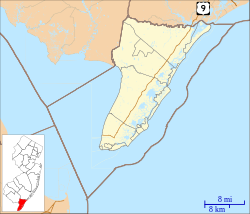Cold Spring Presbyterian Church
Cold Spring Presbyterian Church | |
 | |
| Location | 780 Seashore Road Cold Spring, New Jersey |
|---|---|
| Coordinates | 38°58′35.26″N 74°54′59.11″W / 38.9764611°N 74.9164194°W |
| Built | 1823 |
| Architect | Thomas Hurst Hughes |
| Architectural style | Federal |
| NRHP reference No. | 91000785[1] |
| NJRHP No. | 999[2] |
| Significant dates | |
| Added to NRHP | June 14, 1991 |
| Designated NJRHP | May 1, 1991 |
The Cold Spring Presbyterian Church is a Presbyterian church in Cold Spring, New Jersey, founded in 1714.
Building
[edit]The historic two-story red brick building located at 780 Seashore Road in the Cold Spring section of Lower Township, in Cape May County, New Jersey. The current church building, known as "Old Brick", was constructed in 1823[3] by Thomas H. Hughes, who was also the architect of Congress Hall in Cape May, New Jersey. This red brick building replaced a frame and shingle church erected in 1764, which itself replaced a 1714 log meetinghouse.[4] The church's cemetery, Cold Spring Presbyterian Cemetery, is the site of a 1742 grave (that of Sarah Eldridge Spicer) and of the most Mayflower descendants anywhere outside Massachusetts. The church was added to the National Register of Historic Places on June 14, 1991, for its significance in settlement, architecture, religion, and government.[5]
History
[edit]The congregation was founded in 1714. The first regular pastor was John Bradner, who served from 1715 until 1721. Hughston Hughes was pastor for one year, starting in 1726, before being dismissed for "his too free use of intoxicating drinks."[4]
Samuel Finley was pastor for several years. Finley, who was a graduate of the Log College, later became president of the College of New Jersey, the predecessor of Princeton University. Another Log College graduate, Daniel Lawrence, was pastor from 1752 until his death in 1766. His tombstone in the adjacent graveyard was inscribed
In yonder sacred house I spent my breath,
Now, silent, mouldering here I lie in death,
Those silent lips shall wake and yet declare,
A dread amen to truths they publish there[4]
The two hundredth anniversary of the church was celebrated on August 16, 1914. President Woodrow Wilson sent a congratulatory letter.[6]
-
Church and Cemetery
-
On a pre-1923 postcard
-
View from the southwest. Note that the rear section was added since the postcard picture
Notable burials
[edit]| Cold Spring Presbyterian Cemetery | |
|---|---|
 Veterans Field of Honor at the cemetery | |
 | |
| Details | |
| Find a Grave | Cold Spring Presbyterian Cemetery |
- T. Millet Hand (1902–1956), represented New Jersey's 2nd congressional district in the United States House of Representatives from 1945 to 1957.[7]
- J. Thompson Baker (1847–1919), represented New Jersey's 2nd congressional district in the United States House of Representatives from 1913 to 1915.[8]
- Thomas H. Hughes (1769–1839), represented New Jersey's at-large congressional district in the United States House of Representatives from 1829 to 1833.[9]
- Charles W. Sandman Jr. (1921–1985), represented New Jersey's 2nd congressional district in the United States House of Representatives from 1913 to 1915.[10]
- Lieutenant Richard Wickes (died June 29, 1776) American Revolutionary War, mortally wounded at the Battle of Turtle Gut Inlet.[11]
-
Memucan Hughes, II (1857)
See also
[edit]References
[edit]- ^ "National Register Information System". National Register of Historic Places. National Park Service. November 2, 2013.
- ^ "New Jersey and National Registers of Historic Places - Cape May County" (PDF). New Jersey Department of Environmental Protection - Historic Preservation Office. March 27, 2019. p. 4.
- ^ "Old Brick; About Us". Cold Spring Presbyterian Church. Archived from the original on 2008-08-28. Retrieved 2012-06-03.
- ^ a b c "Famous Old New Jersey Church, A Presbyterian Congregation Formed 182 Years Ago". The New York Times. May 3, 1896., reprinted in "The First Resort," Ben Miller, Exit Zero Publishing, 2009, Cape May, New Jersey.
- ^ Craig, Robert (November 20, 1990). "National Register of Historic Places Inventory/Nomination: Cold Spring Presbyterian Church". National Park Service. With accompanying 25 pictures
- ^ "Church 200 Years Old". The New York Times. August 17, 1914. Retrieved August 17, 2012.
- ^ Thomas Millet Hand, Biographical Directory of the United States Congress. Accessed August 16, 2007.
- ^ Jacob Thompson, Biographical Directory of the United States Congress. Accessed August 16, 2007.
- ^ Thomas Hurst Hughes, Biographical Directory of the United States Congress. Accessed August 16, 2007.
- ^ Charles William Sandman, Jr., Biographical Directory of the United States Congress. Accessed August 16, 2007.
- ^ "Revolutionary War Sites in Cape May, New Jersey".
External links
[edit]- Official website
 [1]
[1] - Historic American Buildings Survey (HABS) No. NJ-270, "Cold Spring Presbyterian Church, West side Seashore Road, Cold Spring, Cape May County, NJ", 9 photos, 5 data pages, 1 photo caption page
- "Cape May Landmarks: Cold Spring Church" - Cape May Times Article
- Cold Spring Presbyterian Cemetery at The Political Graveyard
- Lower Township, New Jersey
- Churches completed in 1823
- 19th-century Presbyterian church buildings in the United States
- Churches on the National Register of Historic Places in New Jersey
- Presbyterian churches in New Jersey
- Cemeteries in Cape May County, New Jersey
- U.S. Route 9
- Churches in Cape May County, New Jersey
- National Register of Historic Places in Cape May County, New Jersey
- New Jersey Register of Historic Places
- 1714 establishments in New Jersey
- Presbyterian cemeteries in New Jersey
- Historic American Buildings Survey in New Jersey








